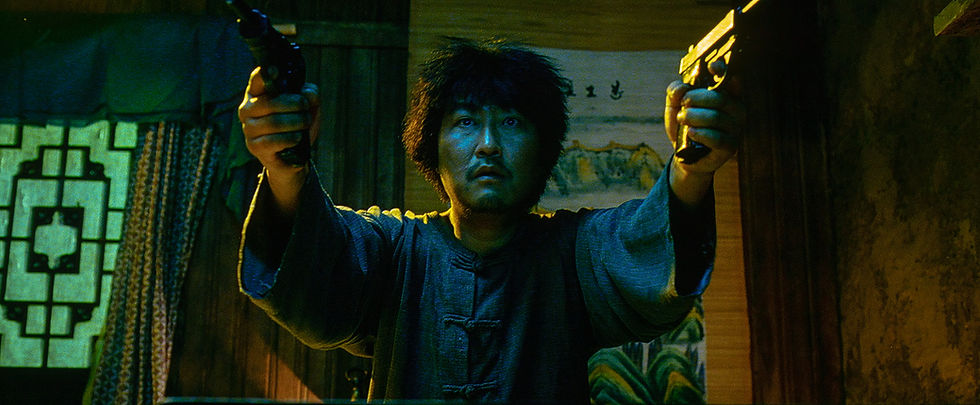Before “Dragnet” and “CSI,” there was “He Walked By Night”
- Peggy Earle

- Apr 3, 2024
- 6 min read
BLU-RAY REVIEW / SCREENSHOTS
Ruthless killer Roy Morgan (Richard Basehart) shows up at the home of electronic store owner Paul Reeves (Whit Bissell) wanting more money.
(Click an image to scroll the larger versions)
“HE WALKED BY NIGHT”
Blu-ray; 1948; Not Rated
Best extra: Commentary by author and film historian Imogen Sara Smith
WITH ITS faux-documentary format, it’s no surprise that “He Walked By Night” inspired Jack Webb’s long-running TV series, “Dragnet,” especially since the film was Webb’s first screen appearance. The film is based on an actual case, with the “names changed to protect the innocent.” It opens with a sober-sounding narrator setting the scene for this dark police procedural, starring Richard Basehart as Roy Morgan, the ruthless object of a Los Angeles PD manhunt.
It’s the wee hours and Morgan is trying to pick the door lock of a radio/television supply shop, but an approaching car stops him. He walks away and drops his gloves and tools into the bushes, while the car makes a U-turn and heads his way. The driver just happens to be an off-duty LA police officer, heading home. He stops the suspicious Morgan demanding “some kind of identification,” Morgan offers his “Army discharge” papers and then pulls out a pistol and fatally wounds him with three slugs. What follows is painstaking work by police to detect the killer’s identity, using the latest technology available, as we get glimpses of Morgan planning future crimes, and cleverly evading discovery – at least for a while.
(1) The low-budget Eagle-Lion Films presentation was mostly filmed on Los Angeles streets and the city’s 700 miles of storm sewers by uncredited director Anthony Mann. (2) Second unit footage from the LAPD command center. (3&4) Morgan is trying to pick the door lock of a radio/television supply shop, but an approaching car stops him. (5&6) Off-duty officer Robert Rollins (John McGuire) questions Morgan and within seconds three bullets hit Rollins.
VIDEO/AUDIO
A brand new 16-bit 4K scan of the best available source – 35mm (1.37:1 aspect ratio) fine grain positive – gives new life to this film noir classic. The Kino Lorber Studio Classics Blu-ray with its clarity and grayscale is substantially better than the previous 2017 ClassicFlix release. From highlights to mid-tones and deep dark shadows, this disc is more balanced and adds better sharpness from the 4K master. Frames from cinematographer John Alton (“T-Men” (1947), and “Raw Deal”) have been restored removing marks and scratches and the best results are during the third reel.
The 2.0 mono DTS-HD soundtrack is front and center. Many moments have just natural sound and no music from composer Leonid Raab.
EXTRAS
The Blu-ray comes with two commentaries, one by Alan K. Rode and Julie Kirgo – originally recorded for the ClassicFlix disc; the other by Imogen Sara Smith.
Smith, whose specialty is film noir, meticulously dissects “He Walked By Night,” which she grants is “an example of the semi-documentary style that flourished in the 1940s.” She cites the casting of the actor Reed Hadley for the “voice of God narrator,” which, she says, is quite different from the type of voice-overs used in film noir. True crime as the basis for a film (or a TV series, for that matter) is, as we know, still extremely popular to this day. Smith spends a lot of time discussing the co-direction of the film, for which only Alfred Werker is credited, while Anthony Mann (“Winchester ‘73,” “The Naked Spur”) is believed to have directed many scenes, especially the ones featuring Basehart. Mann, says Smith, was known as a “master of action and cinematic violence.”
(1) Left, LAPD Captain Breen (Roy Roberts) questions a witness (Jack Bailey) who heard the three gunshots. (2) The LAPD rounds up possible suspects in the killing of Officer Rollins. (3) A description of the killer is broadcast on the radio and Morgan shaves off his pencil mustache. (4) Right, LAPD lab technician Lee Whitley (Jack Webb - his first onscreen role) inspects the items found in Morgan’s car.
The movie production code at that time “demanded that films uphold law and order,” so “He Walked By Night” is told mostly from the perspective of the police. It was made only two years after the actual events occurred in Los Angeles, and Smith notes that the real perpetrator was eventually diagnosed with a form of PTSD. Eagle Lion, the studio that made the film, was one of a group known as “Poverty Row Studios,” because of their low budgets. Smith says “He Walked By Night” was made for just over $300,000, so corners were cut whenever possible, such as using recycled footage when possible.
Smith points out that there are no female characters in the entire film, only a handful of women in bit parts. As we’ve come to expect from Smith’s fine commentaries, she’s done plenty of homework on the lives and careers of the players. She notes that Basehart’s character of Morgan is given a bit of depth by his owning, and showing affection to, a dog. In real life, Basehart was an outspoken supporter of animal welfare, and was against using them for scientific testing. The actor had worried that his role in the film was too small, with too few lines, but his performance was noticed and highly praised by critics.
Smith describes the character of Morgan as a kind of early “techno-geek,” working with, and selling the various electronics he steals. Almost all of Basehart’s first ten screen appearances were in noir or noir-adjacent films, notes Smith, but Federico Fellini hired him to be in two of his features, including “La Strada,” one of his most famous.
Jack Webb was a radio actor before his role in the film. He got to know the policeman who was a consultant on it, which certainly helped in the conception of “Dragnet.” Eventually, the LAPD would use episodes of the TV show for training. The department so loved Webb, it even retired the badge number he’d used as Sgt. Joe Friday. Webb was actually more interested in producing and creating projects than acting in them, but his greatest passion, says Smith, was for jazz. He had a jazz radio show and directed and starred in Warner Brothers “Pete Kelly’s Blues” (1955) as the Kansas City cornet player. Neither one was very successful.
(1&2) Morgan tries to sell a Cathode-Ray Oscillograph to electronic store owner Paul Reeve. Sergeants Chuck Jones (James Cardwell) and Marty Brennan (Scott Brady) get Reeves to phone Morgan to finalize the deal. (3) Morgan spots Jones and Brennan and shots are fired. (4&5) Witnesses to a string of liquor store robberies by Morgan formulate a composite portrait of the killer.
Smith talks about the immediately recognizable character actor Whit Bissell. The “ubiquitous supporting actor,” she says, was “so nondescript he could play almost anything.” Throughout his career, Bissell did a lot of work in low-budget, horror, and science fiction movies: “He does abject fear very well.”
Focusing on scenes directed by Mann, Smith points out that they’re expressionistic, have almost no dialogue, and therefore rely on “visual storytelling.” The cinematography by Alton enhanced those scenes, such as using partial lighting of faces from below, making them ominous and “almost abstract.” Smith says, “He Walked By Night” was literally “one of the darkest films of the era,” but thanks to Alton, outlines were always very sharp, giving it a graphic, almost woodcut-like look. Smith also comments on the general lack of music, which gives the film a “stripped-down” quality, and “sharpens the suspense.” Death scenes, adds Smith, are prominent in Mann films, but they typically always come off as “flat and defeated,” reflecting the director’s personal hatred of violence. Mann, whom Smith dubs an “auteur” with a recognizable style, directed several crime thrillers for Eagle-Lion: “T-Men” (1947), and “Raw Deal” (1948). As a result, says Smith, that little studio often “punched above its weight.”
The climactic suspenseful storm drain chase scene, notes Smith, was filmed in retakes. The original showdown between the police and Morgan was shot in a stadium. Interestingly, “He Walked By Night” came out one year before Carol Reed’s “The Third Man.” Smith says she finds it hard to believe Reed hadn’t seen the former film, considering the well-known scene of Orson Welles’ Harry Lime being pursued like a “rat in a maze,” through the Vienna sewers.
— Peggy Earle




















































Full Review:
It's good to see this film now getting the attention it has always deserved. For those who understand filmmaking as an art and appreciate the care some would take to create early mini-masterpieces, this is a must-see.
As it was made by a smaller production company (Eagle Lion) that specialized in high-quality entertainment produced on lower budgets, the stars, while fully competent, were not of the well known calibre of the major studios – still, with the creativity and passion of talented film makers they produced several critically acclaimed minor classics. But those weaned on glossy consumer movies may not completely appreciate the full professional impact they achieved. Great visuals, direction, and performances combine to make this one…